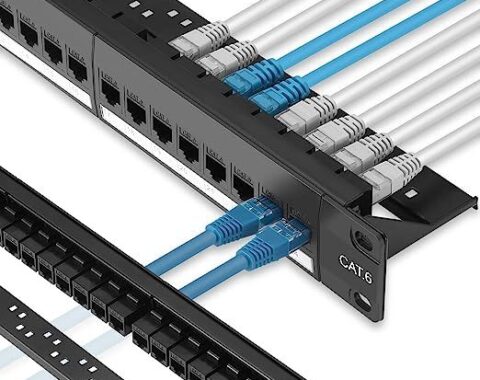Structured Networking refers to a standardized approach to designing and implementing network infrastructure**. It ensures that both wired and wireless networks are well-organized, scalable, secure, and easy to manage. Rather than relying on a disorganized or ad hoc network layout, structured networking follows a clear plan using quality cabling, logical routing, and consistent practices.
It forms the foundation of your entire digital ecosystem ,supporting communication, data transfer, internet access, cloud services, and IoT systems.
Wired Networking:
Wired networking is often referred to as the “backbone of connectivity” because it forms the core physical infrastructure that supports the entire network — especially in environments where speed, stability, and security are critical.
Key Elements:
Ethernet Cables: Carry data between devices.
Network Switches & Routers: Manage and direct data traffic.
Patch Panels & Racks: Organize and manage cable connections.
Network Interface Cards (NICs): Enable devices to connect via cables.
Benefits of Wired Networking:
1. Speed and Reliability: Delivers consistent high-speed connections, ideal for data-intensive environments.
2. Low Latency: Crucial for real-time applications like VoIP, video conferencing, or medical imaging.
3. Security: Physical access is required, making unauthorized access harder.
4. Minimal Interference: Not affected by walls, microwaves, or other wireless devices.
5. Long-Term Investment: Cabling infrastructure can last 10-15+ years with proper planning.
This typed of structured is recommended for the below facilities or sections in a room.
Server rooms and data centers
Administrative offices
Labs and research facilities
CCTV and access control systems
Sensitive environments (e.g., hospitals or banks)
Wireless Networking:
Wireless networking is referred to as flexibility without limits because it allows users to connect to a network from virtually anywhere within coverage range, without being physically tied to cables. This freedom enhances mobility, supports a wide range of devices (like smartphones, tablets, and laptops), and enables seamless access in environments where wired connections would be impractical or costly such as open offices, campuses, or hospital wards. As organizations grow or reconfigure their spaces, wireless networks can easily scale and adapt, making them incredibly flexible and efficient for modern-day connectivity needs.
Key Elements of Wireless Networking:
1. Wireless Access Points (WAPs):
Devices that broadcast Wi-Fi signals and connect wireless devices to the wired network.
2. Wireless Routers:
Combine the functions of a router and WAP, providing internet access and managing wireless connections.
3. Wireless Network Interface Cards (NICs):
Built into most devices (laptops, smartphones, tablets) to enable wireless communication.
4. Controllers (Optional):
Centralized devices used in larger networks to manage multiple access points efficiently.
5. Antennas:
Enhance signal strength and range, especially in larger or complex environments.
6. Authentication & Security Protocols:
Protect the network using encryption standards like WPA2, WPA3, and authentication methods (e.g., 802.1X).
Benefits of Wireless Networking:
1. Mobility & Convenience: Users can move freely while staying connected.
2. Easy to Scale: Add new devices or users with minimal infrastructure changes.
3. Reduced Cabling: Ideal for large buildings or campuses.
4. Support for BYOD: Accommodates mobile phones, tablets, laptops, and smart devices.
This kind of structured of networking is recommended for:
1. Classrooms, lecture halls, and libraries.
2. Patient care areas and hospital wards.
3. Open-plan offices and common areas.
4. Conference rooms and event spaces.
5. Outdoor areas (e.g., campuses or compounds)
Why Structured Networking Is Essential?
1. Scalability.
Structured networks are **built to grow**. As your institution expands, new devices and users can be added without a full redesign.
2. Performance.
Poorly designed networks lead to lag, dropped connections, and productivity loss. Structured networks ensure maximum uptime and speed.
3. Security.
Segmented and organized networks reduce vulnerabilities. They allow for stronger firewalls, encryption, and access control policies.
4. Ease of Troubleshooting.
With labeled cables, organized racks, and centralized controls, issues can be quickly diagnosed and resolved.
5. Compliance.
Industries like healthcare, finance, and education often require networks that meet regulatory standards for data handling and privacy.
6. Professional Appearance.
Neatly installed and concealed cabling reflects a professional, efficient organization, especially important for client-facing environments.
So Who Needs Structured Networking, or who does it benefit?
a).Large Corporates & Offices – For efficient operations, collaboration, and communication
b).Hospitals & Clinics – For EHR systems, medical equipment, patient Wi-Fi, and security
c).Learning Institutions – For e-learning platforms, smart boards, campus-wide Wi-Fi
d).Government Agencies – For secure, high-availability communications and data transfer
e).Research Centers & Labs – For high-speed data processing and device connectivity
At Simplified Communications Limited, we specialize in structured cabling and professional network setup both wired and wireless ,tailored to your needs.
✅Custom Network Design
✅Installation & Configuration
✅Maintenance & Support
✅Scalable & Future-Proof Infrastructure
In conclusion, Wired and wireless networking are both essential components of a modern, structured network. Wired networking offers unmatched speed, stability, and security, making it ideal as the core backbone for high-performance and mission-critical systems. Wireless networking, on the other hand, provides flexibility and mobility, allowing users to connect from anywhere within range — perfect for dynamic environments and mobile devices. When combined strategically, they create a powerful, scalable, and efficient network infrastructure that supports the current and future needs of any organization. For institutions like businesses, hospitals, schools, and government bodies, investing in a well-planned structured network ensures seamless communication, improved productivity, and long-term reliability.




Your sentences resonate like remembered melody, evoking subtle insight and reflection. Each phrase encourages attentive reading, contemplative thought, and mindful engagement.
Reading this evokes a sense of memory and recognition. Each phrase hints at something familiar, unlocking quiet resonance and introspection.